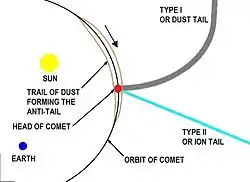Anti-tail
An antitail is an apparent spike projecting from a comet's coma which seems to go towards the Sun, and thus geometrically opposite to the other tails: the ion tail and the dust tail. However, this phenomenon is an optical illusion that is seen from the Earth. The antitail consists of larger dust particles, which are less affected by the Sun's radiation pressure and tend to remain roughly in the comet's orbital plane and eventually form a disc along the comet's orbit due to the ejection speed of the particles from the comet's surface. As Earth passes through the comet's orbital plane, this disc is seen side on, and appears as the characteristic spike.[1] The other side of the disc can sometimes be seen, though it tends to be lost in the dust tail. The antitail is therefore normally visible for a brief interval only when Earth passes through the comet's orbital plane.[2][3]


Most comets do not develop sufficiently for an antitail to become visible, but notable comets that did display antitails include Comet Arend–Roland in 1957,[1] Comet Kohoutek in 1973,[4] Comet Hale–Bopp in 1997, Comet Lulin in 2009, Comet PANSTARRS in 2013, and C/2022 E3 (ZTF) in 2023.[5]
See also
- Comet tail
- The coma and tail at the main Comet article.
- Limb brightening
Notes
- David Darling (2016). "Encyclopedia of science:antitail".
- Rao, Joe (6 February 2009). "Newfound Comet Lulin to Grace Night Skies". SPACE.com. Archived from the original on 26 February 2009. Retrieved 2009-02-25.
- Tosar, Borja; Paolo Candy. "What is an antitail". 3.bp.blogspot. Archived from the original on 25 February 2009. Retrieved 2009-02-25.
- Naugles, John E. (7 March 1974). "Statement of John E. Naugle, Associate Administrator for Space Science, NASA: Comet Kohoutek Program". Committee on Science and Astronautics U.S. House of Representatives. Hearings Before the Subcommittee on Space Science and Applications. Washington DC. 25 (3): 401. Retrieved 2021-11-10.
[drawing on page 403] the Skylab crewmen observed a brilliant spike or anti tail projecting toward the Sun from the head of Kohoutek [...] Dr Zdenek Sekanina concluded that the spike was not wholly due to a perspective or geometrical effect as has been assumed in previous comet studies.
- Harry Baker (2023-01-27). "Optical illusion gives rare green comet an 'anti-tail' that seemingly defies physics". Space.com. Retrieved 2023-01-28.
External links
- Emily Lakdawalla (2009-02-23). "Got binoculars? Spot a comet near Saturn tonight".
- Photo of Comet Arend-Roland in 1957 with prominent antitail.

.png.webp)